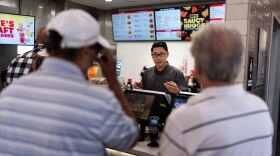Last month, Ford announced it would allow staff who have been working remotely to remain remote — at least some of the time — long after the pandemic is over.
"Must be nice for them," thought Marcie Pedraza, an electrician at a Ford plant in Chicago. Like many workers across the U.S., from factories to grocery stores, working from home has never been an option for her. And that presents a challenge for companies frantically rewriting their remote work policies: How do you make the change feel fair, when not all employees can benefit?
This divide — between those who have to show up to work, and those who can log in to Zoom — didn't used to be so stark. Before the pandemic only 3% of workers logged in from home full-time. The rest of us commuted — whether by luxury car or jalopy, by bicycle or bus, to a factory or an office or a studio.
But as of last summer, one study found fully 42% of the U.S. labor force was working from home. The pandemic had wrought a huge transformation, with astonishing speed.
"In 24 hours, we went from less than 1,000 employees working remotely, globally, to around 80,000," says Kiersten Robinson, the chief people and employee experiences officer at Ford Motor Company. "So how quickly we were able to pivot and adjust to remote work really surprised me. I would never have anticipated that."
Engineering, design and marketing could all be done from home, it turns out. But assembly ... not so much.
"Cars have got to be built," Pedraza says. "You've got to do that in person."
Pedraza says some of her work could be done remotely — she handles a lot of paperwork — and as a single parent, she'd love any flexibility. But when she asked about doing some work from home last year, she says her boss told her that hourly workers weren't eligible. It was disappointing, but not a surprise. She says working remotely is a luxury that she's not afforded.
The last year has been a prolonged crisis, with many companies and workers making do under tough circumstances. And not everybody loves working from home. But for many white-collar workers, working remotely was a significant silver lining. For some, like people with disabilities or those with caregiving responsibilities, it was life-changing, opening up new job opportunities or allowing them to keep working when they might otherwise have had to quit.
While some companies prepare to call workers back to the office now that vaccines are widely available, others — including Ford and rival GM — are embracing remote work for the long haul.
Ford, of course, took part in another work revolution more than a century ago. Henry Ford famously transformed factories with the moving assembly line, and the rise of the automobile helped reshape cities (and commutes).
Now, Ford says, even once the pandemic is over, staff can work remotely when their job allows it. Instead of assigned desks, workers will reserve office space when they need it — a process called "hoteling."
Many other companies are adopting similar strategies; one recent study found nearly 80% of companies plan to keep some degree of remote work post-pandemic. But unlike, say, tech companies, a manufacturer like Ford also has to think about its huge pool of workers who have to show up in person.
Robinson says they're trying to think of new amenities to offer workers at plants, so they aren't entirely left out of the changes to Ford workplaces.
"When you finish your shift what if, rather than having to do a stop at the grocery store to pick up food for your family, we had food available that you could preorder a meal to take home to your family?" she asks.
Brett Fox, of the United Auto Worker's union, has some ideas for everyday improvements at plants.
"The air conditioning would help out a lot," he says, noting factory floors get hot in the summer. That would be an expensive upgrade, he acknowledges. He also suggests changes to break rooms, or improved ventilation, to make plants more comfortable.
"You're allowing your salary groups to work from home," he says, laying out the case he'd make to automakers. "Obviously, our members cannot work from home. So we need to do everything we can."
Of course, huge differences between office work and factory work are, well, as old as offices and factories.
But the disparity was only amplified by the pandemic. And not just at auto plants.
"Retail workers, hospitality workers, front-line workers — those who are traditionally the most vulnerable have suffered the most," says Zara Ingilizian, the head of consumer industries at the World Economic Forum. She says there are ways to address this inequity, from making workplaces safer to giving workers more training and opportunities for career growth.
She also points out that there are some jobs we all assume have to be done in person where technology may, eventually, prove those assumptions wrong.
"At some point, maybe the train operator can run the train from their home," she says.
Not every job can go remote. But Ingilizian argues that employers need to think more expansively so the workers who risked the most during the pandemic don't get left out of a wave of post-pandemic workplace improvements.
Copyright 2021 NPR. To see more, visit https://www.npr.org.






